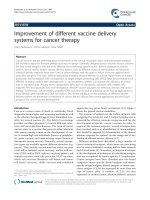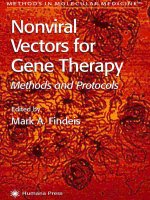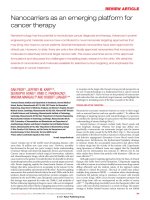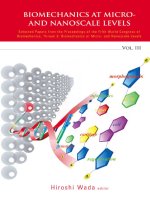- Trang chủ >>
- Khoa Học Tự Nhiên >>
- Vật lý
nanotechnology for cancer therapy, 2007, p.810
Bạn đang xem bản rút gọn của tài liệu. Xem và tải ngay bản đầy đủ của tài liệu tại đây (20.79 MB, 810 trang )
q 2006 by Taylor & Francis Group, LLC
q 2006 by Taylor & Francis Group, LLC
q 2006 by Taylor & Francis Group, LLC
Dedication
To the loving memory of my dad,
Mustafa Amiji, and to my mom, Shirin Amiji
q 2006 by Taylor & Francis Group, LLC
Foreword
We are at the threshold of a new era in cancer treatment and diagnosis, brought about by the
convergence of two disciplines—materials engineering and life sciences—that 30 years ago might
have been difficult to envision. The product of this curious marriage, nanobiotechnology, is yielding
many surprises and fostering many hopes in the drug-development space. Nanoparticles,
engineered to exquisite precision using polymers, metals, lipids, and carbon, have been combined
with molecular targeting, molecular imaging, and therapeutic techniques to create a powerful set of
tools in the fight against cancer. The unique properties of nanomaterials enable selective drug
delivery to tumors, novel treatment methods, intraoperative imaging guides to surgery, highly
sensitive imaging agents for early tumor detection, and real-time monitoring of response to
treatment.
Using nanotechnology, it may be possible to leap over many of the hurdles of cancer drug
delivery that have confounded conventional drugs. These hurdles include hindered access to the
central nervous system through the blood–brain barrier, sequestration by the reticulo-endothelial
system, inability to penetrate the interior of solid tumors, and overcoming multi-drug resistance
mechanisms. These obstacles can be mitigated by manipulating the size, surface charge,
hydrophilicity, and attached targeting ligands of a therapeutic nanoparticle.
The novelty of using nanotechnology for medical applications presents its own challenges,
similar in many ways to the challenges faced by the introduction of the first synthetic protein-based
drugs. In the early 1980s, protein-based drugs offered an entirely new approach to targeting and
treating disease. They could be “engineered” to be highly specific and even offered the capability of
separating the targeting and therapeutic functions of a drug, such as when monoclonal antibodies
are conjugated to cytotoxic agents. But monoclonal antibodies and recombinant protein-based
drugs necessitated a different approach to lead optimization, metabolism, and toxicity screening
from that of small-molecule drugs. Factors such as stability, immunogenicity, and species
specificity had to be considered and tested in ways that were not familiar to the developers of
traditional drugs.
Nanotechnology-based drugs will catalyze a reevaluation of optimization, metabolism, and
toxicity-screening protocols. Interactions between novel materials and biological pathways are
largely unknown but are widely suspected to depend heavily on physical and chemical
characteristics such as particle size, particle size distribution, surface area, surface chemistry
(including charge and hydrophobicity), shape, and aggregation state—features not usually
scrutinized for traditional drugs. Standard criteria for physicochemical characterization will have to
be established before safety testing can yield interpretable and reproducible results.
Would nanotechnology-based drugs be successful? All drugs have to run an obstacle course
through physiological and biochemical barriers. For monoclonal antibody drugs, only a minute
portion of an intravenously administered drug reaches its target. However, drugs based on
nanomaterials, including nanoparticles, have unique properties that enable them to specifically bind
to and penetrate solid tumors. Size and surface chemistries can be manipulated to facilitate
extravasation through tumor vasculature, or the therapeutic agent can be encapsulated in polymer
micelles or liposomes to prevent degradation and increase circulation half-life to improve the odds
of it reaching the target.
This level of functional engineering has not been available to either small-molecule or protein-
based drugs. For these drugs, modification of one characteristic, such as solubility or charge, can
have dramatic effects on other essential characteristics, such as potency or target specificity.
Nanoparticles, however, introduce a much higher degree of modularity and offer at least four
advantages over the antibody conjugates: (1) the delivery of a larger therapeutic payload per target
recognition event, enhancing potency; (2) the ability to carry multiple targeting agents, enhancing
q 2006 by Taylor & Francis Group, LLC
selectivity; (3) the ability to carry multiple therapeutic agents, enabling targeted combination
therapies; and (4) the ability to bypass physiological and biological barriers.
We would all like to hasten the day when chemotherapy—the administration of non-specific,
toxic anti-cancer agents—is relegated to medical history. Improvements in diagnostic screening
and the development of drugs that target specific biological pathways have begun to turn the tide
and contribute to a slow, yet consistent decline in death rates. While confirming that early diagnosis
and targeted therapies are pointing us in the right direction, the progress is still incremental.
Nanotechnology may be our best hope for overcoming many of the barriers faced by today’s drugs
in the battle against cancer. The combined creative forces of engineering, chemistry, physics, and
biology will beget new and hopefully transformative options to old, intractable problems.
Piotr Grodzinski, Ph.D.
National Cancer Institute
q 2006 by Taylor & Francis Group, LLC
Preface
With parallel breakthroughs occurring in molecular biology and nanoscience/technology, the newly
recognized research thrust on “nanomedicine” is expected to have a revolutionary impact on the
future of healthcare. To advance nanotechnology research for cancer prevention, diagnosis, and
treatment, the United States National Cancer Institute (NCI) established the Alliance for
Nanotechnology in Cancer in September 2004 and has pledged $144.3 million in the next five years
(for details, visit ). Among the approaches for exploiting developments in
nanotechnology for cancer molecular medicine, nanoparticles offer some unique advantages as
sensing, delivery, and image enhancement agents. Several varieties of nanoparticles are available,
including polymeric conjugates and nanoparticles, micelles, dendrimers, liposomes, and
nanoassemblies.
This book focuses specifically on nanoscientific and nanotechnological strategies that are
effective and promising for imaging and treatment of cancer. Among the various approaches
considered, nanotechnology offers the best promise for targeted delivery of drugs and genes to the
tumor site and alleviation of the side effects of chemotherapeutic agents. Multifunctional
nanosystems offer tremendous opportunity for combining more than one drug or using drug and
imaging agents. The expertise of world-renowned academic and industrial researchers is brought
together here to provide a comprehensive treatise on this subject.
The book is composed of thirty-eight chapters divided into seven sections that address the
specific nanoplatforms used for imaging and delivery of therapeutic molecules. Section 1 focuses
on the rationale and fundamental understanding of targeting strategies, including pharmacokinetic
considerations for delivery to tumors in vivo, multifunctional nanotherapeutics, boron neutron
capture therapy, and the discussion on nanotechnology characterization for cancer therapy, as well
as guidance from the U.S. Food and Drug Administration on approval of nanotechnology products.
Section 2 focuses on polymeric conjugates used for tumor-targeted imaging and delivery, including
special consideration on the use of imaging to evaluate therapeutic efficacy. In Section 3, polymeric
nanoparticle systems are discussed with emphasis on biodegradable, long-circulating nanoparticles
for passive and active targeting. Section 4 focuses on polymeric micellar assemblies, where
sophisticated chemistry is applied for the development of novel nanosystems that can provide
efficient delivery to tumors. Many of the micellar delivery systems are undergoing clinical trials in
Japan and other countries across the globe. Dendritic nanostructures used for cancer imaging and
therapy are discussed in Section 5. Section 6 focuses on the oldest nanotechnology for cancer
therapy—liposome-based delivery systems—with emphasis on surface modification to enhance
target efficiency and temperature-responsive liposomes. Lastly, Section 7 focuses on other lipid
nanosystems used for targeted delivery of cancer therapy, including nanoemulsions that can cross
biological barriers, solid-lipid nanoparticles, lipoprotein nanoparticles, and DQAsomes for
mitochondria-specific delivery.
Words cannot adequately express my admiration and gratitude to all of the contributing authors.
Each chapter is written by a world-renowned authority on the subject, and I am deeply grateful for
their willingness to participate in this project. I am also extremely grateful to Dr. Piotr Grodzinski
for providing the Foreword. Drs. Fredika Robertson and Mauro Ferrari have done a superb job in
laying the foundation by providing a chapter entitled “Introduction and Rationale for
Nanotechnology in Cancer.” I am grateful to Professor Kinam Park at Purdue University,
Professor Robert Langer at MIT, and Professor Vladimir Torchilin at Northeastern University, who
have been my mentors and collaborators, as well as many other researchers from academia and
industry. Special thanks are due to the postdoctoral associates and graduate students in my
laboratory at Northeastern University who have been the “soldiers in the trenches” in our quest to
use nanotechnology for the targeted delivery of drugs and genes to solid tumors. Lastly, I am deeply
q 2006 by Taylor & Francis Group, LLC
grateful to the wonderful people at Taylor & Francis-CRC Press, including Stephen Zollo, Patricia
Roberson, and many others, who have made the concept of this book into reality.
Any comments and constructive criticisms of the book can be sent to the editor at
q 2006 by Taylor & Francis Group, LLC
Editor
Dr. Mansoor M. Amiji received his undergraduate degree in pharmacy from Northeastern
University in 1988 and his PhD in pharmaceutics from Purdue University in 1992. His areas of
specialization include polymeric biomaterials, advanced drug delivery systems, and nanomedical
technologies.
Dr. Amiji’s research interests include the synthesis of novel polymeric materials for medical and
pharmaceutical applications; surface modification of cationic polymers by the complexation-
interpenetration method to develop biocompatible materials; the preparation and characterization
of polymeric membranes and microcapsules with controlled permeability properties for medical
and pharmaceutical applications; target-specific drug and vaccine delivery systems for
gastrointestinal tract infections; localized delivery of cytotoxic and anti-angiogenic drugs for
solid tumors in novel biodegradable polymeric nanoparticles; intracellular delivery systems for
drugs and genes using target-specific, long-circulating, biodegradable polymeric nanoparticles; and
gold and iron-gold core-shell nanoparticles for biosensing, imaging, and delivery applications. His
research has received sustained funding from the National Institutes of Health (NIH), the National
Science Foundation (NSF), foundations, and local industries.
Dr. Amiji is Professor and Associate Chair of the Pharmaceutical Sciences Department and Co-
Director of the Northeastern University Nanomedicine Education and Research Consortium
(NERC). The NERC oversees a doctoral training grant in nanomedicine science and technology
that was co-funded by the NIH and NSF. He has two published books, Applied Physical Pharmacy
and Polymeric Gene Delivery: Principles and Applications, along with numerous manuscript
publications. He has also received a number of awards, including the 2003 Eurand Award for
Innovative Oral Drug Delivery Research, Third Prize.
Dr. Amiji has supervised the research efforts of over 50 postdoctoral associates, doctoral and
master’s level graduate students, and undergraduate honors students over the last 13 years. His
teaching responsibilities include the Doctor of Pharmacy (PharmD) program and graduate
programs (MS and PhD) in pharmaceutical sciences, biotechnology, and nanomedicine.
q 2006 by Taylor & Francis Group, LLC
Contributors
Hamidreza Montazeri Aliabadi
Department of Pharmacy and Pharmaceutical
Sciences
University of Alberta
Edmonton, Alberta, Canada
Christine Allen
Department of Pharmaceutical Sciences
and
Department of Chemical Engineering and
Applied Chemistry
University of Toronto
Toronto, Ontario, Canada
Ashootosh V. Ambade
Department of Chemistry
University of Massachusetts at Amherst
Amherst, Massachusetts
Mansoor M. Amiji
Department of Pharmaceutical Sciences
Northeastern University
Boston, Massachusetts
Joseph M. Backer
SibTech, Inc.
Newington, Connecticut
Marina V. Backer
SibTech, Inc.
Newington, Connecticut
You Han Bae
Department of Pharmaceutics and
Pharmaceutical Chemistry
University of Utah
Salt Lake City, Utah
Lajos P. Balogh
Department of Radiation Medicine
and
Department of Cellular Stress and
Cancer Biology
Roswell Park Cancer Institute
Buffalo, New York
Rolf F. Barth
Department of Pathology
The Ohio State University
Columbus, Ohio
Reina Bendayan
Department of Pharmaceutical Sciences
University of Toronto
Toronto, Ontario, Canada
Tania Betancourt
The University of Texas at Austin
Austin, Texas
D. Bhadra
Department of Pharmaceutical Sciences
Dr. H.S. Gour University
Sagar, India
S. Bhadra
Department of Pharmaceutical Sciences
Dr. H.S. Gour University
Sagar, India
Sangeeta N. Bhatia
Harvard–MIT Division of Health Sciences
and Technology
Massachusetts Institute of Technology
Cambridge, Massachusetts
Sarathi V. Boddapati
Department of Pharmaceutical Sciences
Northeastern University
Boston, Massachusetts
Lisa Brannon-Peppas
The University of Texas at Austin
Austin, Texas
Mark Butler
Department of Chemical Engineering
and Applied Chemistry
University of Toronto
Toronto, Ontario, Canada
John C. Byrd
Division of Hematology–Oncology
NCI Comprehensive Cancer Center
The Ohio State University
Columbus, Ohio
q 2006 by Taylor & Francis Group, LLC
Robert B. Campbell
Department of Pharmaceutical Sciences
Northeastern University
Boston, Massachusetts
Shing-Ming Cheng
Department of Pharmaceutical Sciences
Northeastern University
Boston, Massachusetts
Gerard G. M. D’Souza
Department of Pharmaceutical Sciences
Northeastern University
Boston, Massachusetts
Marina A. Dobrovolskaia
Nanotechnology Characterization Laboratory
NCI Frederick
Frederick, Maryland
Amber Doiron
The University of Texas at Austin
Austin, Texas
P. K. Dubey
Department of Pharmaceutical Sciences
Dr. H. S. Gold University
Sagar, India
Omid C. Farokhzad
Department of Anesthesiology, Perioperative
and Pain Medicine
Brigham and Women’s Hospital and Harvard
Medical School
Boston, Massachusetts
Mauro Ferrari
The Brown Foundation Institute of
Molecular Medicine
M. D. Anderson Cancer Center
and
Alliance for Nanohealth
The University of Texas
Houston, Texas
Alberto A. Gabizon
Oncology Institute
Shaare Zedek Medical Center and
Hebrew University
Jerusalem, Israel
Jinming Gao
Simmons Comprehensive Cancer Center
University of Texas Southwestern
Medical Center
Dallas, Texas
Hamidreza Ghandehari
Department of Pharmaceutical Sciences
University of Maryland
Baltimore, Maryland
Todd J. Harris
Harvard–MIT Division of Health Sciences
and Technology
Massachusetts Institute of Technology
Cambridge, Massachusetts
Mitsuru Hashida
Department of Drug Delivery Research
Graduate School of Pharmaceutical Sciences
Kyoto University
Sakyo-ku, Kyoto, Japan
Yuriko Higuchi
Department of Drug Delivery Research
Graduate School of Pharmaceutical Sciences
Kyoto University
Sakyo-ku, Kyoto, Japan
Kang Moo Huh
Department of Polymer Science
and Engineering
Chungnam National University
Yuseong-Gu, Daejeon, South Korea
Edward F. Jackson
Division of Diagnostic Imaging
The University of Texas M. D. Anderson
Cancer Center
Houston, Texas
N. K. Jain
Department of Pharmaceutical Sciences
Dr. H.S. Gour University
Sagar, India
Eun-Kee Jeong
Department of Radiology
University of Utah
Salt Lake City, Utah
q 2006 by Taylor & Francis Group, LLC
Ji Hoon Jeong
Department of Pharmaceutics and
Pharmaceutical Chemistry
University of Utah
Salt Lake City, Utah
Sangyong Jon
Department of Life Science
Gwangju Institute of Science and Technology
Gwangju, South Korea
Shigeru Kawakami
Department of Drug Delivery Research
Graduate School of Pharmaceutical Sciences
Kyoto University
Sakyo-ku, Kyoto, Japan
Mohamed K. Khan
Department of Radiation Medicine
and
Department of Cellular Stress and
Cancer Biology
Roswell Park Cancer Institute
Buffalo, New York
Chalermchai Khemtong
Simmons Comprehensive Cancer Center
University of Texas Southwestern
Medical Center
Dallas, Texas
Sun Hwa Kim
Department of Biological Sciences
Korea Advanced Institute of Science
and Technology
Daejeon, South Korea
Tae-il Kim
School of Chemistry and Molecular
Engineering
Seoul National University
Seoul, South Korea
Sushma Kommareddy
Department of Pharmaceutical Sciences
Northeastern University
Boston, Massachusetts
Vinod Labhasetwar
Departments of Pharmaceutical Sciences and
Biochemistry and Molecular Biology
University of Nebraska Medical Center
Omaha, Nebraska
Andras G. Lacko
Departments of Molecular Biology and
Immunology
University of North Texas Health Science
Center
Fort Worth, Texas
Robert Langer
Department of Chemical Engineering
Massachusetts Institute of Technology
Cambridge, Massachusetts
Afsaneh Lavasanifar
Department of Pharmacy and Pharmaceutical
Sciences
University of Alberta
Edmonton, Alberta, Canada
Eun Seong Lee
Amorepacific Corporation/R&D Center
Giheung-gu Yongin-si Gyeonggi-do
South Korea
Helen Lee
Department of Pharmaceutical Sciences
University of Toronto
Toronto, Ontario, Canada
Robert J. Lee
NCI Comprehensive Cancer Center
and
NSF Nanoscale Science and
Engineering Center
The Ohio State University
Columbus, Ohio
Sang Cheon Lee
Nanomaterials Application Division
Korea Institute of Ceramic Engineering and
Technology
Guemcheon-gu, Seoul, South Korea
Chun Li
M. D. Anderson
Cancer Center
The University of Texas
Houston, Texas
Yongqiang Li
Department of Pharmaceutical Sciences
University of Toronto
Toronto, Ontario, Canada
q 2006 by Taylor & Francis Group, LLC
Bruce R. Line
Department of Radiology, and Greenebaum
Cancer Center
University of Maryland
Baltimore, Maryland
Jubo Liu
Department of Pharmaceutical Sciences
University of Toronto
Toronto, Ontario, Canada
Zheng-Rong Lu
Departments of Pharmaceutics and
Pharmaceutical Chemistry
University of Utah
Salt Lake City, Utah
S. Mahor
Department of Pharmaceutical Sciences
Dr. H. S. Gour University
Sagar, India
Walter J. McConathy
Department of Internal Medicine
University of North Texas Health Science
Center
Fort Worth, Texas
Scott E. McNeil
Nanotechnology Characterization Laboratory
NCI Frederick
Frederick, Maryland
T. J. Miller
Center for Drug Evaluation and Research
Food and Drug Administration
Silver Spring, Maryland
Amitava Mitra
Department of Pharmaceutical Sciences and
Center for Nanomedicine and
Cellular Delivery
University of Maryland
Baltimore, Maryland
S. M. Moghimi
Molecular Targeting and Polymer
Toxicology Group
School of Pharmacy
University of Brighton
Brighton, United Kingdom
Randall J. Mrsny
Center for Drug Delivery/Biology
Welsh School of Pharmacy
Cardiff University
Cardiff, United Kingdom
R. S. R. Murthy
Pharmacy Department
The M.S. University of Baroda
Vadodara, India
Natarajan Muthusamy
NCI Comprehensive Cancer Center
The Ohio State University
Columbus, Ohio
Anjan Nan
Department of Pharmaceutical Sciences and
Center for Nanomedicine and
Cellular Delivery
University of Maryland
Baltimore, Maryland
Maya Nair
Departments of Molecular Biology and
Immunology
University of North Texas Health
Science Center
Fort Worth, Texas
Norased Nasongkla
Simmons Comprehensive Cancer Center
University of Texas Southwestern
Medical Center
Dallas, Texas
David Needham
Department of Mechanical Engineering
and Materials Science
Duke University
Durham, North Carolina
Tooru Ooya
Department of Materials Science
Japan Advanced Institute of Science
and Technology
Tatsunokuchi, Ishikawa, Japan
q 2006 by Taylor & Francis Group, LLC
Jong-Sang Park
Department of Chemistry and Molecular
Engineering
Seoul National University
Seoul, South Korea
Kinam Park
Departments of Pharmaceutics and
Biomedical Engineering
Purdue University
West Lafayette, Indiana
Tae Gwan Park
Department of Biological Sciences
Korea Advanced Institute of Science and
Technology
Daejeon, South Korea
Anil K. Patri
Nanotechnology Characterization Laboratory
NCI Frederick
Frederick, Maryland
Ana Ponce
Department of Biomedical Engineering
Duke University
Durham, North Carolina
Natalya Rapoport
Department of Bioengineering
University of Utah
Salt Lake City, Utah
Mike Andrew Rauth
Department of Pharmaceutical Sciences
University of Toronto
Toronto, Ontario, Canada
L. Harivardan Reddy
Pharmacy Department
The M.S. University of Baroda
Vadodara, India
Fredika M. Robertson
College of Medicine and Comprehensive
Cancer Center
The Ohio State University
Columbus, Ohio
N. Sadrieh
Center for Drug Evaluation and Research
Food and Drug Administration
Silver Spring, Maryland
Sanjeeb K. Sahoo
Department of Pharmaceutical Sciences
Nebraska Medical Center
Omaha, Nebraska
and
Institute of Life Sciences
Bhubaneswar, India
Elamprakash N. Savariar
Department of Chemistry
University of Massachusetts at Amherst
Amherst, Massachusetts
Dinesh B. Shenoy
Department of Pharmaceutical Sciences
Northeastern University
Boston, Massachusetts and Novavax, Inc.
Malvern, Pennsylvania
Patrick Lim Soo
Department of Pharmaceutical Sciences
University of Toronto
Toronto, Ontario, Canada
Stephan T. Stern
Nanotechnology Characterization
Laboratory
NCI Frederick
Frederick, Maryland
S. (Thai) Thayumanavan
Department of Chemistry
University of Massachusetts at Amherst
Amherst, Massachusetts
Sandip B. Tiwari
Department of Pharmaceutical Sciences
Northeastern University
Boston, Massachusetts
Werner Tjarks
College of Pharmacy
The Ohio State University
Columbus, Ohio
q 2006 by Taylor & Francis Group, LLC
Vladimir P. Torchilin
Department of Pharmaceutical Sciences
Northeastern University
Boston, Massachusetts
Anagha Vaidya
Departments of Pharmaceutics and
Pharmaceutical Chemistry
University of Utah
Salt Lake City, Utah
Geoffrey von Maltzahn
Harvard–MIT Division of Health Sciences
and Technology
Massachusetts Institute of Technology
Cambridge, Massachusetts
S. P. Vyas
Department of Pharmaceutical Sciences
Dr. H. S. Gour University
Sagar, India
Sidney Wallace
Division of Diagnostic Imaging
The University of Texas M. D. Anderson
Cancer Center
Houston, Texas
Yanli Wang
Departments of Pharmaceutics and
Pharmaceutical Chemistry
University of Utah
Salt Lake City, Utah
Volkmar Weissig
Department of Pharmaceutical Sciences
Northeastern University
Boston, Massachusetts
Ho Lun Wong
Department of Pharmaceutical Sciences
University of Toronto
Toronto, Ontario, Canada
Gong Wu
Department of Pathology
The Ohio State University
Columbus, Ohio
Xiao Yu Wu
Department of Pharmaceutical Sciences
University of Toronto
Toronto, Ontario, Canada
Xiao-Bing Xiong
Faculty of Pharmacy and Pharmaceutical
Sciences
University of Alberta
Edmonton, Alberta, Canada
Weilian Yang
Department of Pathology
The Ohio State University
Columbus, Ohio
Furong Ye
Departments of Pharmaceutics and
Pharmaceutical Chemistry
University of Utah
Salt Lake City, Utah
Guodong Zhang
M. D. Anderson
Cancer Center
The University of Texas
Houston, Texas
Xiaobin B. Zhao
NCI Comprehensive Cancer Center
The Ohio State University
Columbus, Ohio
.
q 2006 by Taylor & Francis Group, LLC
Table of Contents
Section 1
Nanotechnology and Cancer 1
Chapter 1 Introduction and Rationale for Nanotechnology
in Cancer Therapy . 3
Fredika M. Robertson and Mauro Ferrari
Chapter 2 Passive Targeting of Solid Tumors: Pathophysiological
Principles and Physicochemical Aspects of
Delivery Systems . . 11
S. M. Moghimi
Chapter 3 Active Targeting Strategies in Cancer with a Focus on
Potential Nanotechnology Applications . 19
Randall J. Mrsny
Chapter 4 Pharmacokinetics of Nanocarrier-Mediated
Drug and Gene Delivery . . . 43
Yuriko Higuchi, Shigeru Kawakami, and Mitsuru Hashida
Chapter 5 Multifunctional Nanoparticles for Cancer Therapy. . . . 59
Todd J. Harris, Geoffrey von Maltzahn, and Sangeeta N. Bhatia
Chapter 6 Neutron Capture Therapy of Cancer: Nanoparticles
and High Molecular Weight Boron Delivery Agents. . . 77
Gong Wu, Rolf F. Barth, Weilian Yang, Robert J. Lee, Werner Tjarks, Marina V. Backer, and
Joseph M. Backer
Chapter 7 Preclinical Characterization of Engineered Nanoparticles
Intended for Cancer Therapeutics . 105
Anil K. Patri, Marina A. Dobrovolskaia, Stephan T. Stern, and Scott E. McNeil
Chapter 8 Nanotechnology: Regulatory Perspective for Drug
Development in Cancer Therapeutics . . 139
N. Sadrieh and T. J. Miller
Section 2
Polymer Conjugates. . 157
Chapter 9 Polymeric Conjugates for Angiogenesis Targeted Tumor
Imaging and Therapy . . . . . . 159
Amitava Mitra, Anjan Nan, Bruce R. Line, and Hamidreza Ghandehari
q 2006 by Taylor & Francis Group, LLC
Chapter 10 Poly(L-Glutamic Acid): Efficient Carrier of Cancer Therapeutics and
Diagnostics . . . . . 185
Guodong Zhang, Edward F. Jackson, Sidney Wallace, and Chun Li
Chapter 11 Noninvasive Visualization of In Vivo Drug Delivery
of Paramagnetic Polymer Conjugates with MRI. . 201
Zheng-Rong Lu, Yanli Wang, Furong Ye, Anagha Vaidya, and Eun-Kee Jeong
Section 3
Polymeric Nanoparticles . . . . . . 213
Chapter 12 Polymeric Nanoparticles for Tumor-Targeted Drug
Delivery. 215
Tania Betancourt, Amber Doiron, and Lisa Brannon-Peppas
Chapter 13 Long-Circulating Polymeric Nanoparticles for Drug and
Gene Delivery to Tumors . . . 231
Sushma Kommareddy, Dinesh B. Shenoy, and Mansoor M. Amiji
Chapter 14 Biodegradable PLGA/PLA Nanoparticles for Anti-cancer
Therapy . 243
Sanjeeb K. Sahoo and Vinod Labhasetwar
Chapter 15 Poly(Alkyl Cyanoacrylate) Nanoparticles for Delivery
of Anti-Cancer Drugs . . 251
R. S. R. Murthy and L. Harivardhan Reddy
Chapter 16 Aptamers and Cancer Nanotechnology 289
Omid C. Farokhzad, Sangyong Jon, and Robert Langer
Section 4
Polymeric Micelles . . . 315
Chapter 17 Polymeric Micelles for Formulation of Anti-Cancer Drugs. . . . . 317
Helen Lee, Patrick Lim Soo, Jubo Liu, Mark Butler, and Christine Allen
Chapter 18 PEO-Modified Poly(
L-Amino Acid) Micelles for
Drug Delivery . . . 357
Xiao-Bing Xiong, Hamidreza Montazeri Aliabadi, and Afsaneh Lavasanifar
Chapter 19 Hydrotropic Polymer Micelles for Cancer Therapeutics 385
Sang Cheon Lee, Kang Moo Huh, Tooru Ooya, and Kinam Park
Chapter 20 Tumor-Targeted Delivery of Sparingly-Soluble Anti-Cancer
Drugs with Polymeric Lipid-Core Immunomicelles . . . 409
Vladimir P. Torchilin
q 2006 by Taylor & Francis Group, LLC
Chapter 21 Combined Cancer Therapy by Micellar-Encapsulated
Drugs and Ultrasound. . . . . 421
Natalya Rapoport
Chapter 22 Polymeric Micelles Targeting Tumor pH. . . . . . 443
Eun Seong Lee and You Han Bae
Chapter 23 cRGD-Encoded, MRI-Visible Polymeric Micelles
for Tumor-Targeted Drug Delivery . . . 465
Jinming Gao, Norased Nasongkla, and Chalermchai Khemtong
Chapter 24 Targeted Antisense Oligonucleotide Micellar
Delivery Systems . 477
Ji Hoon Jeong, Sun Hwa Kim, and Tae Gwan Park
Section 5
Dendritic Nanocarriers 487
Chapter 25 Dendrimers as Drug and Gene Delivery Systems 489
Tae-il Kim and Jong-Sang Park
Chapter 26 Dendritic Nanostructures for Cancer Therapy . . 509
Ashootosh V. Ambade, Elamprakash N. Savariar, and S. (Thai) Thayumanavan
Chapter 27 PEGylated Dendritic Nanoparticulate Carriers of
Anti-Cancer Drugs 523
D. Bhadra, S. Bhadra, and N. K. Jain
Chapter 28 Dendrimer Nanocomposites for Cancer Therapy 551
Lajos P. Balogh and Mohamed K. Khan
Section 6
Liposomes . . . . 593
Chapter 29 Applications of Liposomal Drug Delivery Systems
to Cancer Therapy 595
Alberto A. Gabizon
Chapter 30 Positively-Charged Liposomes for Targeting
Tumor Vasculature 613
Robert B. Campbell
Chapter 31 Cell Penetrating Peptide (CPP)–Modified Liposomal
Nanocarriers for Intracellular Drug and Gene Delivery . . . 629
Vladimir P. Torchilin
q 2006 by Taylor & Francis Group, LLC
Chapter 32 RGD-Modified Liposomes for Tumor Targeting . 643
P. K. Dubey, S. Mahor, and S. P. Vyas
Chapter 33 Folate Receptor-Targeted Liposomes for
Cancer Therapy . . 663
Xiaobin B. Zhao, Natarajan Muthusamy, John C. Byrd, and Robert J. Lee
Chapter 34 Nanoscale Drug Delivery Vehicles for Solid Tumors:
A New Paradigm for Localized Drug Delivery
Using Temperature Sensitive Liposomes . . . 677
David Needham and Ana Ponce
Section 7
Other Lipid Nanostructures . . . . 721
Chapter 35 Nanoemulsion Formulations for Tumor-Targeted Delivery . . . . . 723
Sandip B. Tiwari and Mansoor M. Amiji
Chapter 36 Solid Lipid Nanoparticles for Antitumor Drug Delivery 741
Ho Lun Wong, Yongqiang Li, Reina Bendayan, Mike Andrew Rauth, and Xiao Yu Wu
Chapter 37 Lipoprotein Nanoparticles as Delivery Vehicles
for Anti-Cancer Agents 777
Andras G. Lacko, Maya Nair, and Walter J. McConathy
Chapter 38 DQAsomes as Mitochondria-Targeted Nanocarriers
for Anti-Cancer Drugs . 787
Shing-Ming Cheng, Sarathi V. Boddapati, Gerard G. M. D’Souza, and Volkmar Weissig
q 2006 by Taylor & Francis Group, LLC
1
Introduction and Rationale
for Nanotechnology
in Cancer Therapy
Fredika M. Robertson and Mauro Ferrari
CONTENT
References 8
Although there have been significant advances in defining the fundamentals of cancer biology over
the past 25 years, this has not translated into similar clinical advances in cancer therapeutics. One
area that holds great promise for making such advances is the area defined as cancer nanotech-
nology, which involves the intersection of a variety of disciplines, including engineering, materials
science, chemistry, and physics with cancer biology. This multidisciplinary convergence has
resulted in the creation of devices and/or materials that are themselves or have essential com-
ponents in the 1–1000-nm range for at least one dimension and holds the possibility of rapidly
advancing the state of cancer therapeutics and tumor imaging.
This newly developing area of “nanohealth” may ultimately allow detection of human tumors at
the very earliest stages, regardless of the location of the primary tumor and/or metastases, and may
provide approaches to more effectively destroy tumors as well as their associated vascular supplies
with fewer adverse side effects. The chapters within this book describe the most recent cutting-edge
approaches in nanotechnology that are focused on overcoming the multiple barriers that have, in the
past, blocked the successful treatment and ultimate eradication of human cancers.
The majority of nanotechnology-based devices useful for cancer therapeutics have been defined
as nanovectors, which are injectable nanoscale delivery systems.
1,2
Nanovectors offer the promise
of providing breakthrough solutions to the problems of optimizing efficacy of therapeutic agents
while simultaneously diminishing the deleterious side-effects that commonly accompany the use of
both single chemotherapeutic agents as well as multimodality therapeutic regimens.
In general, nanovectors are comprised of at least three constituents, which include a core
material, a therapeutic and/or imaging “payload,” and a biological surface modification, which
aids in both appropriate biodistribution and selective localization of the nanovector and its cyto-
toxic and/or imaging agent. Although the first type of molecules used to enhance the selective
localization and delivery of nanovectors were antibodies, more sophisticated recognition systems
have been devised as a result of our expanding knowledge base in cancer biology.
For example, while the biological and molecular characteristics of human tumors of different
origins continue to be defined and exploited for cancer therapeutics and tumor imaging, the signi-
ficance of blood vessels that develop around actively growing tumors as potential therapeutic
3
q 2006 by Taylor & Francis Group, LLC
targets has only been widely recognized and found clinical utility within the past decade.
3,4
The
process of tumor-associated angiogenesis is now known to be an essential component of tumor
expansion and metastasis. This realization and the accompanied potential for development of
successful cancer therapeutics, as well as for tumor imaging strategies based on tumor-associated
vasculature, has opened new doors for the application of nanotechnology in cancer therapeutics.
Additionally, the molecules that drive the process of tumor angiogenesis may provide a means to
gauge the timing and extent of individual patient responses to cancer treatment, which can also be
monitored using nanovector approaches. The importance of tumor neovasculature in cancer nano-
technology is highlighted throughout the chapters in Nanotechnology for Cancer Therapy.
One of the most important characteristics of nanovectors is their ability to be functionalized to
overcome barriers that block access of agents used for treatment of tumors and for imaging of
tumors and their associated vasculature. These biological barriers are numerous and complex. One
such barrier is the blood–brain barrier, which prevents access to brain malignancies, compounding
the difficulties in their successful treatment. One example of the potential utility of nanovectors in
overcoming this biobarrier, which is critical to treatment of malignant brain tumors, is the use of
nanoparticles in combination with boron neutron capture therapy (BCNT). The current approaches
used for BCNT combining nanoparticles and the potential for this nanotechnology-based approach
to treatment of brain tumors is described in detail in a chapter in Nanotechnology for Cancer
Therapy. Additional biobarriers that must be overcome include epithelial–endothelial cell barriers,
the barriers presented by the markedly tortuous structures that are characteristic of angiogenic
vasculature associated with tumors, as well as the barrier set up by the rapid uptake of nanovectors
by resident macrophages within the reticuloendothelial system (RES) which may prevent nano-
vectors from reaching their targeted location.
To achieve breakthrough advances in cancer therapeutics, there are two related and essential
components which must be addressed. The first issue in successful use of nanovectors is recognition
of the tumor and the second is the ability of the nanovector to reach the site of the tumor and
associated blood vessels. The goal is to preferentially achieve high concentrations of a specific
chemotherapeutic agent, a tumor imaging agent, and/or gene therapies at the site(s) of tumors and
associated vasculature. In addition, nanovectors must be able to deliver an active agent to achieve
effective anti-tumor treatment, or tumor imaging, which is essential for tumor diagnosis and for
monitoring the extent and timing of an individual patient’s response to anti-tumor therapy.
The first nanotechnology-based approach to be used as a means of delivering cancer
chemotherapy was liposomes, which is a type of nanovector made of lipids surrounding a water
core. Liposomes are the simplest form of nanovector and their utility is based on the significant
difference in endothelial structures—defined as fenestrations—between normal vasculature and
tumor-associated vessels. The increase in fenestrations in tumor neovasculature allows the prefer-
ential concentration of liposome-encapsulated anti-tumor agent in close proximity to the local
tumor site, a phenomenon defined as enhanced penetration and retention (EPR), which is
considered to be a characteristic of passive targeting of tumors. Both the passive targeting of
solid tumors as well as approaches for active targeting of nanovectors such as liposomes are
described in the following chapters.
The first studies to demonstrate the proof of principle that liposomes could be used as a
nanovector for effective delivery of an active cancer therapeutic was based on the encapsulation
of the anthracycline antibiotic doxorubicin, which is an effective and commonly used first line
chemotherapeutic agent for both leukemia and solid tumors. Although use of doxorubicin is
associated with dose limiting cardiotoxicity, when anionic liposomes were used to encapsulate
doxorubicin, preclinical studies found that the anti-tumor action of doxorubicin was significantly
enhanced and the cardiotoxicity was significantly diminished.
5,6
Liposome encapsulated doxoru-
bicin has now been clearly demonstrated safe and efficacious clinically in such malignancies as
breast and ovarian cancer,
7–9
allowing for greater amounts of this agent to be administered than the
recommended lifetime cumulative dose of free doxorubicin, which was 450–550 mg/m
2
.
Nanotechnology for Cancer Therapy4
q 2006 by Taylor & Francis Group, LLC
Importantly, liposomes have been shown to be an effective means of delivering a diverse group of
anti-tumor agents such as doxorubicin, as well as the poorly soluble drug paclitaxel.
10
As evidenced by the chapters in this volume, interest in improving the use of liposomes for
enhancing the selective localization and delivery of cancer therapeutics to tumors and tumor-
associated blood vessels remains an active area of investigation. Because liposomes can be
modified with respect to composition, charge, and external coating, liposomes remain a versatile
nanotechnology platform, historically serving as the prototypic nanovector.
An approach that was first used with liposome nanovectors that has found utility with other
types of nanovectors is “PEGylation,” a modification of liposome surface characteristics using
poly(ethylene glycol) (PEG), resulting in what has been defined as “sterically stabilized lipo-
somes.” This PEG modification of liposomes provides protection against uptake by resident
macrophages within the RES biobarrier, thus increasing the circulation time of liposome-encapsu-
lated anti-tumor agent, resulting in significantly increased therapeutic efficacy.
11
This approach to overcoming rapid uptake and destruction by resident macrophages within the
RES by PEGylation has been used alone or in tandem with other modifications of liposomes to aid
in avoiding or overcoming biobarriers and to more selectively localize nanovectors. For example,
based on the recognition that a wide variety of solid tumors as well as hematologic malignancies
express amplified levels of the folate receptor on their cell surface, liposome nanovectors have been
developed to target folate receptors.
12,13
Using the strategy of biomarker-based targeting, folate
receptor targeted liposomes have been shown to not only overcome multidrug resistance associated
with P-glycoprotein that often occurs in human tumors, but also have proven to be antiangiogenic.
13
Another means of more selectively localizing liposome-encapsulated anti-tumor agents to tumor-
associated vasculature is to add a cationic charge,
10,14
which has been shown to double the
accumulation of anti-tumor drug encapsulated into liposomes selectively within vessels
surrounding tumors. Other approaches to biomolecular targeting have included the use of specific
proteins such as vasoactive intestinal peptide (VIP)
15
to target gastric tumors as well as signature
RGD amino acid sequences expressed on the surface of endothelial cells that are associated with
expression of a
v
b
3
integrin on angiogenic endothelium.
16
In addition to serving as cancer drug delivery systems, liposomes have been shown to be an
effective means for delivery of other agents such as genes and antisense oligonucleotides, and
would allow access of such entities as small interfering RNA.
13,17
As an example, peptides such as
cell penetrating peptides (CPPs) have been used to modify liposomes, allowing them to be used as a
means for intracellular drug delivery and delivery of proteins such as antibodies and genes, as well
as providing a window for cellular imaging.
17
In addition to liposomes as an example of the prototype of nanovectors, there are many others
now available in the nanotechnology toolbox that are being investigated for use in cancer thera-
peutics and tumor imaging. Polymer-based nanovectors are a specific area of interest in cancer
therapeutics and a number of polymer-based nanovector systems are described in the following
chapters. For the purposes of this volume, polymer-based nanovectors have been subdivided into
several categories, including polymer conjugates, polymeric nanoparticles, and polymeric micelles.
Polymeric conjugates that have been investigated for use as nanovector systems for
delivery of anti-tumor agents include the water soluble biocompatible polymer N-(2-
hydroxypropyl)methacrylamide (HPMA). This polymeric conjugate has been targeted based on
overexpression of hyaluronan (HA) receptors that are present on cancer cells. HPMA–HA polymeric
conjugate drug delivery nanovector systems have been developed to carry a doxorubicin “payload”
and have been shown to have selectivity for endocytosis of the targeted polymeric nanovector to
breast, ovarian, and colon tumor cells, compared to an HPMA polymer with doxorubicin but lacking
the HA targeting conjugate.
18,19
Copolymer–peptide conjugates have also been developed as nano-
vectors using HPMA in combination with RGD targeting peptides,
20
which molecularly target
radiotherapeutic agents to tumor-associated vasculature, resulting in both antiangiogenic as well
as anti-tumor activity. In addition to serving as nanovectors for delivery of chemotherapy and
Introduction and Rationale for Nanotechnology in Cancer Therapy 5
q 2006 by Taylor & Francis Group, LLC









